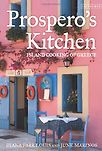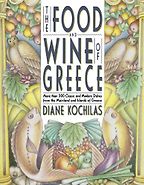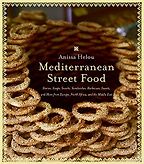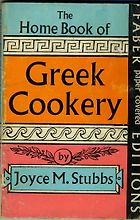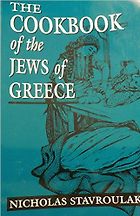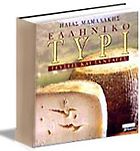Diana – ouzo and tzatziki are the two words that spring to mind when I think of Greek food and drink. I’m sure there is much more to it than that. So what is it that attracts you?
First of all, everything is so fresh and full of flavour. I came to Greece as a tourist in 1963 and June was here even earlier. In those days things were fresh out of gardens and nothing was processed. Luckily we still have farmers’ markets that keep high standards. And I also love the olive oil – you mustn’t forget olive oil.
So when you describe Greek food, it’s really that freshness that appeals to you.
Freshness and the exquisite vegetables. I think that the average tourist who comes to Greece and eats only in a taverna may not be too aware of them because they might stick to well-known foods like moussaka and fried calamari, but we have amazing vegetable dishes, cooked all sorts of ways. In fact, vegetarian friends have told me that Greece is the best country to visit for them.
Well, I’m sure your five book choices will confirm there’s much more to eating in Greece than one might presume, so let’s find out some more with your first book choice, The Food and Wine of Greece by Diane Kochilas.
I was trying to think of the first Greek cookbook I used at home and nothing comes to mind. But when I started researching Prospero’s Kitchen I turned to Diane’s book as a kind of authority because it covers so much of Greek cooking – all the basics, but many more unusual dishes, too. She has a wonderful way of bringing in recipes from all the different regions of the mainland, the islands, Anatolia, and showing the unexpected variety of Greek cuisine in the context of history and tradition. Her book’s drawings also helped me with unfamiliar techniques, like, say, pie making, for I didn’t know much about working with filo pastry at the time. For example, she says that the pita, which is the Greek word for pie, is to Greek cooking what pasta is to Italian. Pies in all shapes, sizes and fillings account for a big section of Greek cooking. She’s also very comprehensive on sweets – how do you like the sound of chocolate baklava?
Five Books interviews are expensive to produce. If you're enjoying this interview, please support us by donating a small amount.
Sounds mouth-watering. Can you tell me a bit more about her and how she got her material?
Diane is a Greek-American – she grew up in New York. Her father was a cook and she came to Greece to find her roots. She started writing about Greek food and she really got into it. She travelled all over the countryside in search of genuine tastes and people, and one thing that comes across in all her books is the welcome, the hospitality she encounters everywhere – which is such an important part of life here. By talking about the people she meets, she brings you into the Greek countryside and such simple pleasures as eating a fish soup cooked by the fisherman himself. And as June and I both know, once you start looking for recipes, most people are only too happy to talk.
What is your favourite recipe from the book?
One of my favourites, though untried, is “Quail-stuffed eggplant – klephtic style”. Klephts were bands of outlaws during the Greek Revolution of 1821 who had to cook on the run without fires and tempting smells. They improvised underground ovens and the name applies to all sorts of sealed, clay-pot cookery. I’ve never attempted this because I’ve never had quail and eggplant at the same time, but it sounds quite wonderful.
I love the cover of Joyce Stubbs’s book, The Home Book of Greek Cookery, which was written in the 1960s. June, can you tell me why you’ve chosen it?
It’s a simple book of classic Greek food that is very easy to follow. The measurements are in pounds and ounces, which is good for people in the UK. She seems to have got a lot of recipes from the woman who cooked in the house for her. There is a very good egg and lemon soup and a stifado, which is a rich dish of beef with lots and lots of small onions. These are all old Greek recipes.
How do you think Greek cooking has changed?
These days they use many more ingredients than they used to and many more herbs and spices. I also think it has changed because of all the cooking programmes on the TV. And, in the old days, many Greek dishes took a long time to make. Nowadays we’ve made short cuts, with the food processor, for example, or ready-made filo, and we tend to use less oil.
What were the key ingredients in the old days?
I suppose tomatoes, garlic, and a lot of oregano. That was the main herb that was used. There were also dishes that combined meat and a special Greek pasta called orzo or kritharaki, which looks like rice. Of course, we followed the seasons more back then, too. I think I prefer cooking the old recipes rather than the new ones.
Back to Diana for my next question. Many things have changed since the 1960s and Greece is currently in a state of flux. What does it feel like living there?
For the last year, I have felt that we’re living in limbo, not knowing how long we’re going to be able to continue to exist normally. So many people are jobless, homeless, desperate, and most of us are gripped by worry. But with this beautiful spring and summer weather, it’s hard to feel so depressed. I noticed today, the day after our second elections, that there was quite a palpable feeling of relief in the air. I’ve just come from the organic farmers’ market and it was absolutely packed. There is such bounty there, you would never think we were having a crisis. In the morning I went to a supermarket and people were shopping casually, not stuffing their carts with staples in a panic.
Why do you think that is?
I think we’re feeling relieved because we feel we’ve bought a little time. I don’t think anyone particularly likes the New Democracy candidate who won a tiny majority but we feel as though the left candidate [from the Syriza party] isn’t quite ready to take over yet. He is 37 years old with no experience! But, generally speaking, you see people being a lot more economical, at least the people we know. We eat out less and buy fewer luxury foods.
Do you think people are going back to the old ways of cooking as a result?
Yes, they probably cook even more lentils, beans and chickpeas than usual and not as much meat and fish. In the past Greek housewives were incredibly imaginative about making food go further – using small amounts of meat with rice, pasta, and all those vegetables. Until the 1980s, Greeks didn’t eat very much meat at all and they were a lot healthier. Now they’ve forgotten the “Mediterranean diet” they were practising without knowing it, but I’m sure all the good traditions of the past will start flooding back.
So that might be seen as an upside of what is going on?
I think it could be an upside as long as we have our olive oil, which makes everything tasty. Cucina povera, Greek-style, is so delicious it won’t be a hardship.
I see that Prospero’s Kitchen is dedicated to the cooking of the Ionian Islands. Could you tell me why you chose this subject and what makes them and their cooking different?
The Ionian Islands were the obvious place to begin our careers as food writers because we knew more about them than any of the other Greek regions. I was writing guidebooks about them but June was the one with the recipes. Her husband is from Zakynthos and that was her introduction to Greek cooking.
So what are your thoughts, June?
I think that Ionian cuisine uses much more garlic than the other Greek regions – that is one of the main things. And also they use a lot of cheese in unusual ways – in stews and stuffings. In Zakynthos there’s a cheese that is preserved in olive oil and their “national dish” is a beef stew with bits of cheese in it. Contrary to the mainland, pies aren’t part of the traditional food. And the islands also have quite a few “English” puddings, left over from when the islands were a British protectorate in the 19th century.
And why has Prospero’s Kitchen become popular once again, Diana?
When it was published in 1995, it was the first cookbook dedicated to the Ionian Islands in any language. The year after, it was translated into Greek, which made us very proud. We republished it in paperback in 2000 with a Corfiot publisher and then it went out of print. Recently IB Tauris, a British firm, found me on Facebook and got in touch with us about republishing it again. It seems somebody in their office had been to Corfu and came back with Prospero’s Kitchen and they loved it. I think its popularity probably stems from the fact that it’s not just a collection of recipes – it’s filled with stories, a bit of history, traditions and personalities that make it a book that’s fun to read as well as rewarding to cook from.
How does Ionian cooking differ to mainland Greek cooking and the Aegean Islands?
One major difference is that the Ionian Islands were never under the domination of the Turks and the Ottomans. In fact, there is an Italian influence because the Venetians were there for 400 years. Of course, this was before pasta and pizza and you have dishes, like sofrito [veal in a white wine sauce], for example, that sound Italian but are not at all the same. In addition to a general influence, each of the islands developed their own special dishes, so, for example, in Corfu you find these wonderful fish stews called bourdettos or a rich pasta casserole called pastitsada with meat or chicken. And Corfu is unusual in that they use hot pepper, which is not found in the rest of Greece, except in Macedonia and Thrace. Also they’re very fond of parsley and, as June said, garlic. I think probably the Ionian people like garlic better than any other Greeks.
You next choice takes us away from specifically focusing on Greece and moves us into the street food of the Mediterranean.
It does and it is just such fun to read. The author Anissa Helou is Lebanese and she is at home virtually anywhere. She speaks French and English and obviously Arabic. She takes you to places that you wouldn’t be able to go on your own and talks about the souks of Egypt or the main square in Marrakesh. But, for me, there is also the nostalgia effect. I lived for a while near Genoa and Genoa has incredible street food, mostly fried, which she describes in her book.
I also like seeing the way the same food appears in different guises. The Greek tiropita (cheese/filo triangle) resembles the Turkish borek and the Lebanese bourekas. The same is true of kebabs or meatballs, whether they’re called kofta, keftedes or kefta. From the book you can see how foods are variations on the same theme, because many of the places she visited used to be part of the Byzantine and Ottoman empires. I find the connections absolutely fascinating.
How would you describe the street food of Greece?
There is a wonderful section in Prospero’s Kitchen where we talk about the street food of the past in Corfu and Zakynthos that is really fun to read. Besides such things as fried fish and grilled artichokes, you could also buy a chunk of bread called the “vouta” or the dunker and dip it into a pot, say, of tripe soup or pans of bubbling innards. You’d have to pay a few pennies more to soak up the oily drippings in the corners! Nowadays we have gyros and souvlakia, roasted meats with pita bread, sesame rings, and sweets like fried semolina cake or, occasionally, doughnut balls with honey.
And what about the food in
The Cookbook of the Jews of Greece by Nicholas Stavroulakis? How does it differ from the food we have been discussing?
I was wondering that myself today when I was looking at it again! Of course, there are the ritual foods, but many of the dishes are clearly indistinguishable from the average Christian Greek food. Then there are still others that have an enormous amount of non-Greek spices. One of my favourites is chicken with okra, which has ginger, turmeric, coriander, bay leaves and lemon, as well as tomatoes, cinnamon and cloves.
Does it actually taste nice, with all those different ingredients?
It’s so good that I lifted it out and put it in my Cretan cookbook. But you don’t have to cook to love this book. First of all Stavroulakis is such a scholar. He curated the Jewish Museums of Athens and Thessaloniki and restored an old synagogue in Chania, Crete, and he is an artist. So besides being a fantastic cook and a writer he also did the pen and ink illustrations for the book. There are drawings of Jews in finery and everyday costumes making bread, dancing, haggling in the market, cooking. It really is a beautiful book.
Is there a big Jewish population in Greece?
Not any more. There was a large population which went back as far as Roman times. There were two types of Jews – Romaniotes and Sephardic Jews. The latter came from Spain when Ferdinand and Isabella kicked them out in 1492. Corfu and Zakynthos both had Jewish communities and in time Thessaloniki came to be called “Mother of Israel”. But during World War II, when Greece was occupied by the Nazis, that all changed. There is an excellent book by Mark Mazower called Salonica: City of Ghosts, which is very good on their stories.
Back to you now, June, to finish with Elliniko Tyri, or Greek Cheese, by Ilias Mamalakis.
This is a fascinating book about Greek cheeses. Greek cheese isn’t only feta! The author has the most wonderful photographs of many different types of cheeses. He talks about where they are made and how they are made. Also he gives a history of cheese from early times and he has a collection of very tempting recipes, also with photographs.
Get the weekly Five Books newsletter
Of the old fashioned recipes, he has pastitsio, which is a macaroni dish with minced meat that you put in the oven. It calls for kefalotiri, a hard piquant yellowish cheese, and then there is stuffed squid which uses feta and another more modern dish, aubergines with manouri, which is an excellent rich white cheese. And there is another delicious dish of pancakes stuffed with asparagus and kasseri, which is a pale yellow cheese that melts beautifully. All these cheeses are made of goat’s milk or sheep’s milk or a mixture. Very few Greek cheeses use cow’s milk.
Finally, what would you recommend people try if they want to eat something that gives them a true flavour of Greek cooking?
They should sit at an ouzeri and have that ouzo you mentioned earlier on. Then they should order practically everything on the menu, which can have up to a hundred wonderful little plates that we call mezedes. They will include anything from taramasalata to eggplant salad to cheese pies and boiled beets with garlic sauce. They can follow up with an assortment of small fish, grilled octopus and minty meatballs. Ideally, they should be sitting by the sea for this feast.
Five Books aims to keep its book recommendations and interviews up to date. If you are the interviewee and would like to update your choice of books (or even just what you say about them) please email us at [email protected]

